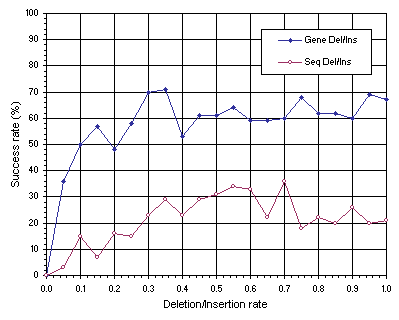|
Buy the Book
Home
News
Author
Q&A
Tutorials
Downloads
GEP Biblio
Contacts
Visit Gepsoft
|
|
|
|
|
Gene Expression Programming: Mathematical Modeling by an Artificial Intelligence
|
|
| Sequence deletion/insertion |
| |
We have seen that the gene deletion/insertion operator described in
section 6.2.2 permits only the transposition of genes, in other words, it allows the transposition of small sequences composed of only one element. A different operator can be easily implemented that deletes/inserts sequences of varied length (sequence deletion/insertion operator). This might appear more advantageous than the deletion/insertion of genes, but experience shows the opposite (see
Figure 6.3). In fact, this operator produces results which are even worse than the restricted permutation operator in the traveling salesperson problem with 19 cities (compare with
Figure 6.2). Indeed, an identical analysis done with this operator showed that sequence deletion/insertion is incapable of solving the 19 cities TSP using population sizes of 100 individuals for 200 generations. Thus, an easier version of the TSP with 13 cities was chosen in order to allow the comparison between gene deletion/insertion and sequence deletion/insertion
(Figure 6.3). For this analysis, a population size of 100 individuals and an evolutionary time of 200 generations were used, that is, exactly the same values of
P and G used in the much harder TSP with 19 cities.

Figure 6.3. Comparison of gene deletion/insertion (Gene Del/Ins) with sequence deletion/insertion (Seq Del/Ins) on the traveling salesperson problem with 13 cities. For this analysis
P = 100 and G = 200. The success rate was evaluated over 100 identical runs.
|
|
|
Home
|
Contents
| Previous
| Next
|
|
